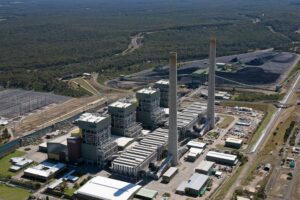
Telstra has offered another tantalising insight into its unfolding energy market strategy, with the suggestion the telco has plans to mobilise its existing battery storage fleet of more than 1GWh, to help balance supply and demand on Australia’s rapidly transforming electricity market.
Speaking at the All-energy Australia conference in Melbourne on Wednesday, Telstra’s executive director of energy, Ben Burge, said the the company’s extensive telecoms infrastructure – including its back-up generation, its plans for renewables, and its considerable energy storage assets – made it a key contender in the critical, grid-wide effort to balance supply and demand.
This, of course, is contingent on a few other things falling into place first – namely the implementation of a 5-minute settlement rule for the National Electricity Market, that is hoped to open the NEM up to a greater range of competition beyond the incumbent gen-tailers.
That should be in place by 2021. And Telstra’s plan will also require some significant technical manoeuvring and replacing of much of its current battery capacity – mostly of the type used in trucks – but this was happening anyway.
That 1 gigawatt hour of storage could be made available to AEMO to help manage peak demand, and provide grid security, in the same way as Tesla’s big battery in South Australia. That facility though is just 100MW/129MWh.
It would transform Telstra from one of the biggest users of electricity in the country – it accounts for 1.5 terawatt hours out of the country’s slightly less than 200TWh, but also into one of the biggest suppliers.
It is also building a large solar farm in north Queensland and plans others to help deflect its own energy costs.
Burge – who was snapped up by Telstra from his role at the helm of upstart energy retailer Powershop – sees many key synergies between the energy industry and the electricity industry. Particular in terms of reliability of service.
“Turn the power off; people get grumpy. Turn off the Facebook feed, and then you really know true hatred,” he quipped.
But of course, keeping the lights on and essential services running is a serious business, and one that the Australian Energy Market Operator is singularly focused upon in the lead up to another Australian summer.
“Since September last year, when we had the state-wide blackout in SA, there have been at least three incidences of being within 50 milliseconds of the same thing happening,” Burge told the conference.
“Yes, we’re a 1.5TWh user of energy … but we also have several hundred megawatts of generation capacity,” he said.
Add to that the coming promise of 5G telecoms technology, and a cumulative battery storage capacity that is 10 times the size of the big battery system Tesla is currently installing in South Australia, and you have some pretty hefty potential.
“Take our battery fleet, we actually have over a gigawatt-hour of batteries in our network,” Burge said.
“Now, at the moment, they’re (largely) truck batteries, so they’re not that useful from a market participation point of view.
“But with 5-minute pricing on the horizon within the next, say, three years, plus a swap-out program that we’ll roll out over the next 5-7 (years), you can see that an industrial customer like Telstra is actually sitting on something that is quite useful in terms of problem of … how you fill in the (supply and demand) gaps.
“For too long we’ve been relying on only half of the equation to match out demand and supply, b/c largely there hasn’t been a signal to the demand-side of the equation,” Burge said.
“In that medium- to long term we are actually very positive and very hopeful about where the market ends up.
“Obviously it’s going to be a bit of a choppy road, between now and then, but we’re really positive.”










